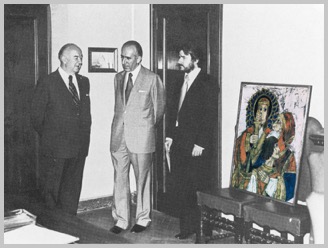Canadian artist Garth Speight’s Vatican success
By Angela Bianchi
Rome – “Art functions with chaos and confusion, that’s why I live in Italy,” says Garth Speight, one of Canada’s brightest and most talented painters.
At age 39, he’s captured the attention and admiration of the Canadian and Italian art community, has had two successful Biblical series, but foremost, he’s the first Canadian to have two paintings acquired by the Vatican for their modern art collection. But to achieve all this he had to leave Canada, says Speight.
“Trudeau said, if you don’t like this country, get out,” he laughs. So Speight, a university arts major, hopped on a plane and came to Italy. That was 10 years ago and he has no regrets.
Speight works in the fresco and gold leaf technique for his portraits and landscape paintings. His work has a Medieval-Byzantine flavour and his style resembles that of turn-of-the-century Austrian painter, Gustav Klimt, an artist Speight says, had the greatest influence on him.
Speight’s landscape paintings are brighter and richer in colour opposed to the solemness of his religious works. The reason for this, says Speight, is the advantage of working in Rome, “where colours seem brighter because of the lack of industrial pollution.”
The painter also suffers from eye astigmatism that makes him see objects taller and thinner than they actually are – and that’s how he paints them.

“Canadians always wait for others to give a seal of approval before they take notice, but what they don’t realise is, when a Canadian makes a name for himself abroad, he usually doesn’t go home,” comments Speight.
That is just his case. After years of gallery exhibitions and art shows in Canada, Speight got fed up of the stagnant Toronto art scene, with, as he puts it, “their snobbish-faddish galleries.”
Speight, one of the few Canadian artists who can earn a living from his art without depending on government grants, praises the Italian art-buying public. “Italians like quality work, unlike the Americans who go for the expensive wallpaper at Piazza Navona,” he says.
He notes a wide gap between the European and North American cultures. “Go to a barbershop in Italy and you’ll see an oil painting on the wall. Go to one in Toronto, and you’re likely to see Miss January or the police gazette on the wall,” he adds.
Settle in Rome with his wife and daughter, Speight is presently working on a series on Italian landscapes, “to capture them in their un-renovated state, before they loose their character,” he says.